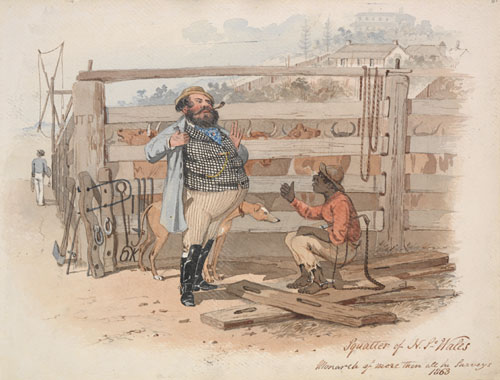Squattocracy
Land adminstration became one of the most important tasks overseen by the colonial government. Before 1826, land grants were given exclusively by the Governor. Grants of land were free until 1825 and could consist of up to 30 acres. In 1826, the limits of location were decreed by Governor Darling and land grants could only be isusued within these boundaries. In 1829, the boundaries were extended to encompass the Nineteen Counties surrounding Sydney.
People choosing to settle on unoccupied land outside the jurisdiction of the Nineteen Counties were classed as 'squatters'. The term (first appearing in 1828) soon came to refer to a person of high social prestige who grazed livestock on a large scale - often having no legal title to the land beyond being the first European to settle on it. Successful squatters were among the wealthiest class of people in the colony and came to be described (in a play on the English aristocracy) as the 'squattocracy'.
 Squatter of N.S.Wales, Monarch of more than all he surveys, 1863, by S. T. Gill.
Squatter of N.S.Wales, Monarch of more than all he surveys, 1863, by S. T. Gill. Watercolour. PXA 1983/ 41
The expanding market for meat due to colonial population growth, and demand for grazing land to meet the needs of the developing sheep industry, provided impetus for increased squatting activity during the 1830s.
In 1837, Robert Dixon, an assistant surveyor working in the Surveyor General's Department in Sydney, produced a unique map of New South Wales which attempted to record the spread of settlement across the colony. It was Dixon's intention to show exactly who owned land in NSW and exactly where that land was, and each property (ie. each piece of 'appropriated land') was annotated with the name of the landholder.
> View an early squatter's map
The concept of areas within and without the Nineteen Counties were discontinued in 1847. After this time New South Wales was divided into three areas - Settled (the former Nineteen Counties), Intermediate and Unsettled. Pastoral leases were available in these three areas for one, eight and forteen years respectively. The squatter's grip on agricultural land in the colony was challenged in the 1860s.
From 1861, the Robertson Act opened all Crown Land for selection until the law changed again in 1884. During this period, land parcels of between 40 and 320 acres could be conditionally purchased without a survey - as long as the purchaser had the funds to improve the land acquired and the intention to occupy it for at least three years.
Squatters, like John Bingle of 'Puen Buen', near Dartbrook, played an important role in development of regional NSW throughout the nineteenth century. In 1879, he recorded his personal reminscences of his squatting days in the colony.
> Read 19th century reminiscences of squatting life

